
SECOND CHANCES
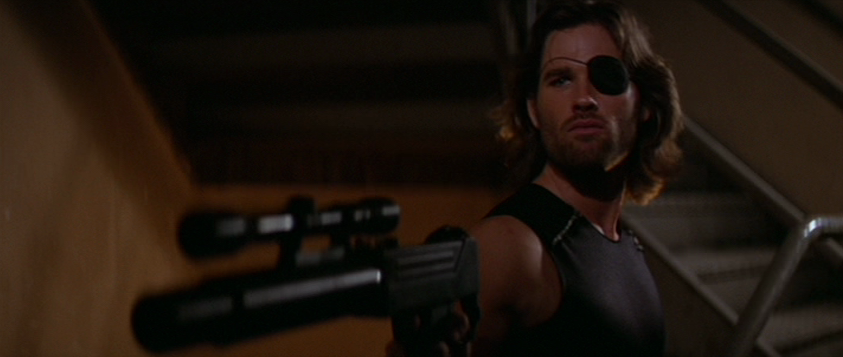
CHRISTOPHER FUNDERBURG
escape from new york (page 2)
The Film:
Well, to make a long story short, I liked the film much better this time through, but still can't quite put it on the level with Carpenter's best. That might even be too simple of an explanation of my feelings: there's a huge amount to enjoy about Escape from New York, but there's something off about it, some essential part of it that just doesn't quite play. When I mentioned to that I was going to do a Second Chances on the film to noted Brian St. Pierre impersonator and John Carpenter superfan John Cribbs he said, "I always forget about Escape, like...it's there. It's fine." I do believe I can also claim the essence of that articulate analysis as mine own as well.
Let's start with what I didn't like about it the first time through: the deadly uncoolness of it all. Most strikingly, several elements of the film that I identified in my memories as being cheesy have aged very well. The dinky synthesizer score does lack muscularity and rambles without purpose, but its essential vibe has come back in style so strongly that it plays much better to my ears now. When I first saw the film, the music I most closely related it to was truly the Doogie Hoswer theme. Now, it sounds uniform with a whole generation of synth-art-rock and its faint tinniness has an endearing, even cool, quality. The same can be said for the vector graphics that appear throughout on computer screens and navigation systems - when I first saw the film, they struck me as low-rent and silly, now they play as crisp, visually striking throwbacks that contrast nicely with the omnipresent overly busy depictions of future technology that have evolved on a through-line from Blade Runner to Minority Report and beyond. A lot of Escape's technological imagery is refreshingly sleek and simple.
That said, this is a film covered wall-to-wall in futro* - that is, it is a film defined by its early 80's aesthetic. Stuff like the vector graphics and synth score are some of the more prominent elements, but Snake Plissken's zubaz/camo pants, Harry Dean Stanton's neckerchief and Adrienne Barbeau's Adrienne Barbeau-ness all reek of 1981. It doesn't help that nearly every car in the film is a late 70's model - sure, you can argue that the technology on Manhattan Prison Island would be frozen in a bygone era, but the island isn't sealed off in the film's imaginary timeline until 1988, so there's no good accounting for the out-of-date automobiles. No accounting for them but futro! (trade-marked.)
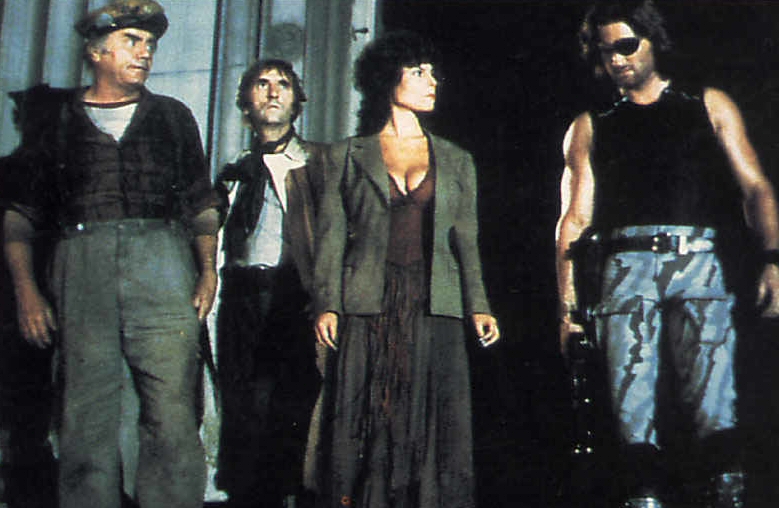
While we're on the subject of 1981 subjectivity, one of the biggest things that jumped out about me is how wrong it gets the future of New York City. The idea that NYC is an irredeemable god-forsaken hellhole is a very late 70's/early 80's "ladies and gentlemen, the Bronx is burning!" kind of concept. There was a decade and a half or so window when the idea of turning Manhattan into a prison island would have been plausible to audiences, but only a five-year or so span before that concept would have carried ugly racial overtones.** By the mid-80's, racial tensions in the city were being so stoked by the media various political figures, and the city so divided along racial lines, that the idea of making it one big prison would have carried the unspoken chaser "...for black people."
My father is fond of making fun of predictions that rely on current trends continuing unabated. "If trends like these continue...there will be no more fish by 2017!" "If we consume coal at the current rate...Central America will be underwater be 2085!" The joke being that trends never continue unabated and that predicting the vagaries of the future to evolve a simple, predictable line is fool's work. Arrows pointed upward do not always continue upward - he's arguing for a more complex analysis of future trends. In this and many other regards, my father is the anti-Disco Stu. Escape from New York, like a lot of science fiction, plays with the idea of "if things are like this now, just imagine how bad they'll be in a few decades!" and it's pretty fun to consider just how colossally wrong it got NYC's future.
By any accounting, NYC is the safest major city in the U.S. and you'd be hard-pressed to identify a safer metropolis in the world, especially once you start getting into the 2 million+ citizens range. Over the course of the two decades since Escape was made, the city went in the exact opposite direction predicted by Carpenter's film. The city was reborn via a mixture of innovative comp-stat police work (informed by the famous "broken windows" theory of crime prevention), a conscious rebranding of its tourist-y elements (the "Disney-fication" of Times Square), stringent gun-control laws (which makes guns in NYC as rare as anywhere in the country***), financial deregulation (which ensured the city would be both insanely wealthy and an international finance Mecca) and nostalgia for the bad ol' days of punk bowery 1981 (which caused an influx of hip youngsters or "hipsters" as I shall call them).
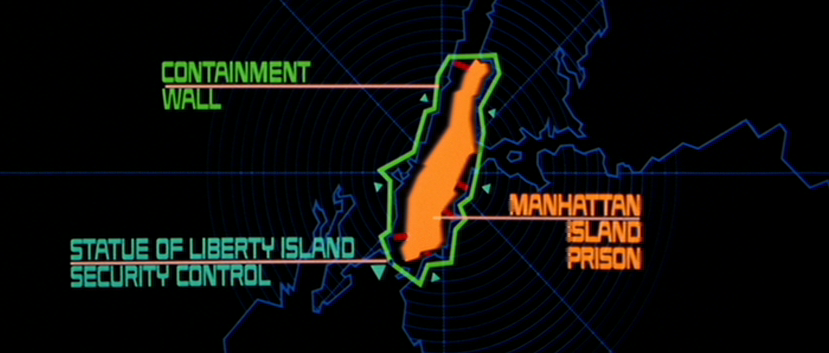
That's one of the funny things about speculative "near-future" sci-fi - it's always hard to say how much they are intended to be literal predictions. On the one hand, the genre is clearly intended as a thought experiment that says more about these times in which we's a-livin', but on the other hand sci-fi aficianados love to make hay about all the predictions people like H.G. Wells, William Gibson and Neal Stephenson got right. Some guys, like Arthur C. Clarke, hang their hat almost entirely about the veracity of their speculation. I think it's fair to guess that Carpenter intends his film less seriously than that and just recognizes he's come up with a cool idea - you never know, though: one of the most eye-opening aspects of John Cribbs' Pink Smoke interview with Mark L. Lester was the fact that he thought his ludicrous Class of 1984 series was a prescient commentary on the state of youth, violence and public school. You expect these guys to understand their films are silly, but you also can't be surprised when they don't.
More generously, I think Escape fits in with the Roger Corman/Larry Cohen school of exploitation sci-fi where these filmmakers are definitely not idiots, but are also way too mercenary to ever let meaning get in the way of fun in films like Death Race 2000, Gas-s-s-s and The Stuff. There's a strong kernal of socio-political commentary in those films, but nothing so serious as to consume the larger entertainment aspects. So while Escape clearly misses on nearly every count about NYC's future, there's enough of a film there that it probably doesn't matter. I will say that it is a constant source of irritation to me how films like Carpenter's get the future wrong - their "decay of moral systems" themes always find their antidotes in rugged individualists like Snake Plissken and never in the things that actually saved places like NYC in reality. Progressive police work, government restriction of individual rights (e.g. gun control), anarchic youth culture and corporatism all combined to save the city, not eye-patched cynics who would rather kick off a nuclear war than see the rescued president get another moment in the sun.
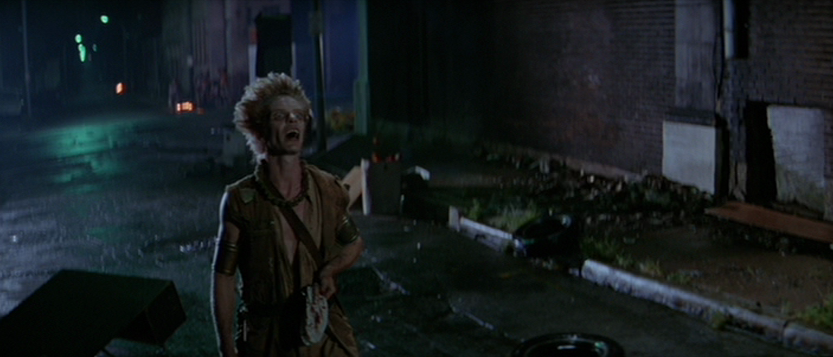
I'm not arguing in favor of one thing or the other, just pointing out that certain anti-social, anti-community anti-heroes like Plissken, Death Wish's Paul Kersey and, most unappetizingly, The Principal's Jim Belushi are presented as the conscience and alternative to dystopian amorality. In reality, it's bureaucrats and young ladies with punk-rock hair-do's that saved NYC with the twin devils of social engineering and hipster gentrification. I'm not saying that's good, but just pointing out that Snake Plissken is plenty at home on Manhattan Prison Island and would be totally out of his element in the tony, pretentious West Village of 2013. I don't even know what Paul Kersey would make of the city. It's probably for the best that he moved to Chicago with its insanely high murder rate and looming demons of white flight. Anyhoo, I think Carpenter would look at me like I'm crazy for even discussing this, but as a resident of NYC, his just got me thinking, is all.
But back to the film itself. The first half hour or so is pretty close to a goddamned masterpiece. There's an energizing lack of explanation as to what's happening and Carpenter is in no hurry to let the events unfold. President Donald Pleasance's plane gets hijacked by an anti-Imperialist rebel decrying his economic polices, he hops in an (extremely futro) escape pod, lands in the prison borough and promptly disappears (he is later revealed to have been kidnapped by Isaac Hayes, A#1 Duke of New York). A warden played by the inexplicably omnipresent Tom Atkins and a military impresario played by Lee Van Cleef make plans to send the recently captured bank robber Snake Plissken over the wall as part of a deal for his clemency...and to deactivate the tiny bombs they've implanted in his jugular veins. There's almost no dialogue in these opening scenes, save Van Cleef's debriefing of Plissken, and Carpenter slow-burns the proceedings into a knot of tension and dread.
Once Snake is over the wall, there's an amazing scene at a burned-out playhouse where a gaggle of men in drag are enthusiastically performing a candy-colored musical for a scattered audience of sleepy-lidded miscreants. Snake pokes around the building (he's been led there by a homing device purportedly attached to the President) and heads down into the basement despite the warning of an avuncular cabbie played by Ernest Borgnine. In the cellar he encounters (and ignores) what appears to be a gang-rape in progress before stumbling upon a filthly vagrant being brutalized over a bathroom sink. The visuals are dimly lit and Carpenter makes brilliant use of his famed ability to play with light and shadows in the edges of his ultra-wide cinemascope frames. There's real menace and ugliness to these scenes and the ante only gets upped when the brutalized vagrant turns out to be enjoying his beating. He's also wearing the tracking bracelet stolen from the President and you instantly feel Snake's sense of hopelessness at the situation.
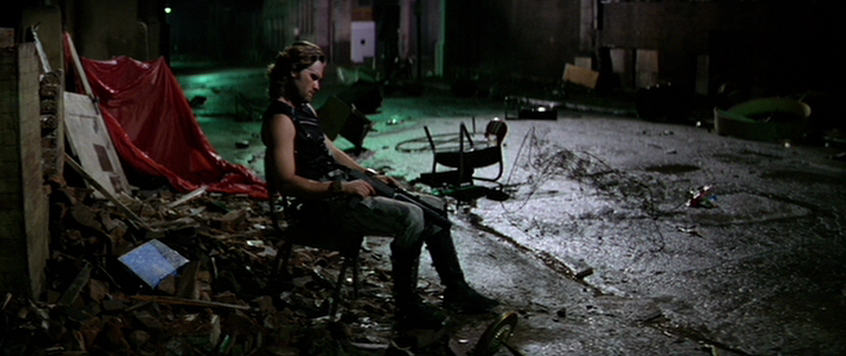
The early goings of the film are when it is at its absolute best, as it builds a believably grotesque and dangerous world around Snake's seemingly hopeless and virtually helpless interloper. There's also a great scene at a diner when a bunch of proto-C.H.U.D.'s pull a hapless young woman down through the floor boards like demons dragging her to hell. Carpenter's vision of the NYC prison colony is nasty, violent and, above all, weird. A certain malaise starts to set in after Carpenter has established his ugly world and the slow burn extinguishes uneventfully. The problem with the film is that once characterization and dialogue start to play a bigger role, it fumbles to sustain to tense weirdness it has built up. Isaac Hayes makes for an unremarkable gang-leader villain - there's nothing really to be said about him other than he's a bigshot, the king of New York. He does have a generically weird sidekick who recalls the memorable homo-eroticized chum of Lord Hummongous in The Road Warrior, and the guy lets out a great, goofy, winded screech when he gets stabbed to death at the end of the film, but again there's nothing to the character beyond being the kind of punk-rock weirdo that action movies of the era loved to toss into the mix.
Sadly to say, even less worth anybody's time are Harry Dean Stanton as a generic smarty-pants (and former heist partner to Plissken) named, now get ready for this because you're never going to believe what the smart guy is called, but they're chosen to call him "Brain." Adrienne Barbeau plays a former girlfriend of the Duke given to Brain for his ability to "keep the oil flowing." He appears to have set up an oil well in the New York Public library, which is...whatever. Lazy? Yeah, lazy. Not Carpenter's most brilliant idea for the film. Barbeau's character exists mainly as a pair of massive boobs spilling out of the plunging neckline of a burgundy evening-gown. As characters, they're lame and uninvolving (until the climax, which I'll touch on in a moment) - Brain's backstory with Snake never pays off, their dialogue is supposed to be funny but ends up falling on the cutesy side of clever (ha ha, everybody thought he was supposed to be dead!) and they only serve to drag the narrative down. Even worse is Borgnine's over-the-top friendly cab-driver - he's just too much for the movie and his explosively goofy-uncle persona overwhelms the sense of menace and disorientation Carpenter has delicately constructed. The moodiness of Escape is a balloon popped over and over by the pin of Borgnine's shit-eating grin.
The deeper Snake gets involved with Brain, Boobs, Cabbie and The Duke, the more somnambulistically trudges forward. About an hour in, I was thinking "No, I'm right, this kinda sucks. I totally remember the reasons for my general indifference." But the finale on the "69th Street Bridge"**** won me back over. First, Barbeau's character justifies her existence by responding to the death of Brain by refusing to escape (from New York) with Snake, instead choosing to suicidally pursue the Duke and blow his brains out for revenge. Her parting with Snake reminded me of Jack Burton's classic farewell to Gracie Law in Big Trouble in Little China, a tender moment shared between hopeless souls. And then she blasts off a chamber's worth of lead at the Duke's chandelier-bedecked Cadillac before getting horrifically crushed Christine-style.
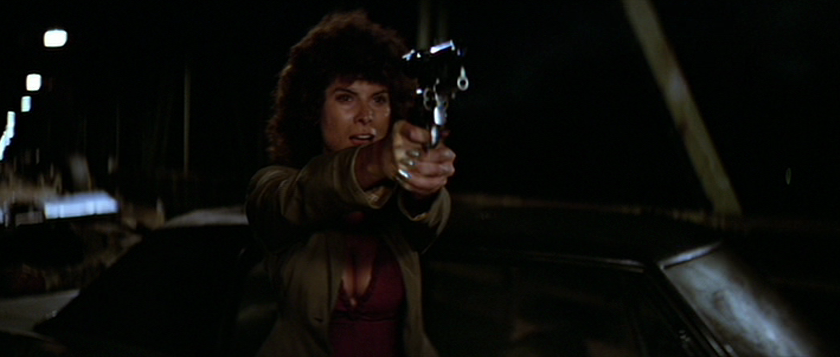
Possibly even more awesome is Pleasance unleashing his revenge on the Duke via submachine gun. Just when it looks like Plissken is cheesed and won't make it over the wall to freedom, Prez pops up atop it with a dead prison guard's assault weapon and unloads a hail of rounds into the Duke all the while shrieking his former tormentor's catchphrase back at him - "You're the Duke of New York, you're A-#1!" - as the man's bullet-riddled corpse sploshes to the pavement. Pleasance is Carpenter's secret weapon in both Escape and Halloween, a preternaturally magnetic screen presence who combines his movie star charisma with a rambling old-man weirdness. His ranting machine-gun massacre comes right on the heels of Barbeau's self-immolation and that one-two punch rights the ship and makes up for the listless preceding half-hour. Sure, I'm aware I'm disparaging Snake's semi-iconic shirtless gladiator battle with a hirsute giant, but Escape's final third consists of a lot of lifeless "go here, now go there" low-stakes wheel-spinning. And while the gladiator battle isn't as embarrassing as Escape from L.A.'s free-throw shootout to the death, it still has a bloodless, stillborn quality and utterly fails to generate excitement.
Overall, the film doesn't achieve the grim, masterful efficiency of Halloween or The Thing, nor does it have the kitchen sink nuttiness of Big Trouble in Little China. It falls in between Carpenter's competing tendencies towards downbeat, quiet mood pieces (Halloween, The Thing) and kitschy thrill-rides (Big Trouble in Little China, In the Mouth of Madness.) His mood pieces work best when the characters disappear into a kind of anonymity - just tell who Fuchs and Palmer are in The Thing, or describe any of the characters but Dr. Loomis in Halloween. His kitsch works best when it goes biggest like in Dark Star or Big Trouble. His mood pieces are better films by most measures, but he's certainly at his most singularly Carpenter-ish when going for broke with 8 minute back-street brawls, nude alien conspiracists and bubble-gum deprived pro wrestlers in films like They Live.
If I had to compare it to another Carpenter film, it would be Assault on Precinct 13, which also features a small group of bad-asses with their backs to the wall in a lawless environment pitted against a cackling rainbow gang with a certain weightlessness to their evil. I know they shoot a kid, but come on - the baddies in Assault are as faceless and undifferentiated as zombies. Both films have a great mood in the early going and slow-burn pacing that never quite explodes. Assault's low-wattage relentlessness and total disinterest in giving depth to its characters ultimately plays better than Escape's uninteresting gaggle of anti-heroes stumbling through a tedious plot, but both films share a "reluctant band of brothers" quality. I would be tempted to think that Escape would benefit from jumping more fully into the crazy-Carpenter mode, but I've seen that version of the film: the silly, lame, virtual remake Escape from L.A. Maybe less Ernest Borgnine is all would have taken to make this a genuine classic.
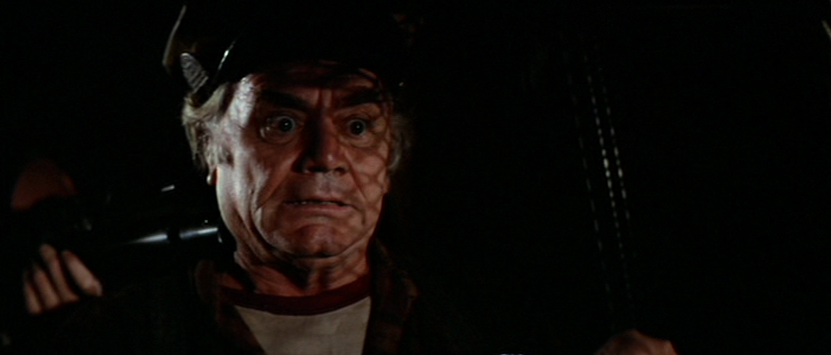
In glorious summation, I'm willing to count Escape as a legit second-tier Carpenter. It is, perhaps, too legit for me to quit it. I'm sure you noticed that its "neither fish nor fowl" qualities in regards to Carpenter's competing artistic tendencies are exactly what I was bemoaning back at the beginning of this article: it isn't as cool as it seems to think it is and can't escape Carpenter's cheesier inclinations. Overall though, it's not as much of an embarrassment as I recalled it being and suffers more from a certain narrative flatness than it does from an overabundance of bottle-cap-chain-mail-clad rainbow-gang psycho-punks (of which it has its fair share). Great character actors like Pleasance and Stanton rescue underwritten characters and the mood built in the first half-hour never fully dissipates, so I can't be too hard even on its most glaring weaknesses. I hereby grant Snake Plissken a full pardon. He's no R.J. MacReady or Jack Burton; but then again, who the hell is?
* Quick refresher: Futro is a term we coined to describe elements of production design intended to look futuristic, but unmistakably of their era. It's a protmanteau of "retro-futuristic." Han Solo's vest is my go-to example, although every costume in the original Battlestar Gallactica t.v. show might be a better demonstration of what I'm talking about - those people are all decked out in Nehru collars and floppy boot-cuts and feathered Farrah Fawcett hair-do's that only could have been made in 1978.
** In Escape, any racial overtones are self-consciously subverted by the rainbow-gang villains - a tactic it has in common with another film preying on paranoia about NYC crime, 1974's Death Wish.
*** Ironically, the lack of guns on the island is one of the few things Escape gets right about the future - folks exclaim upon seeing Snake's government-issued piece "where'd you get a gun?!" and The Duke's posse all wield cross-bows, spears, knives and other makeshift accoutrements de melee.
**** Can we get some Pink Smoke fact-checkers on this? I currently live around the corner from the "59th Street Bridge" aka the Queensboro bridge. I couldn't figure out what the deal was with the whole "69th street" mis-appellation. That's sci-fi in Hollywood for ya, I guess.
RELATED ARTICLES
<<Previous Page 1 2 Next Page>>
home about contact us featured writings years in review film productions
All rights reserved The Pink Smoke © 2013